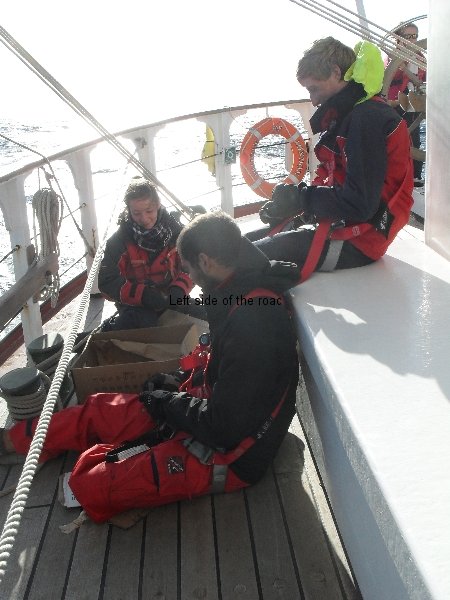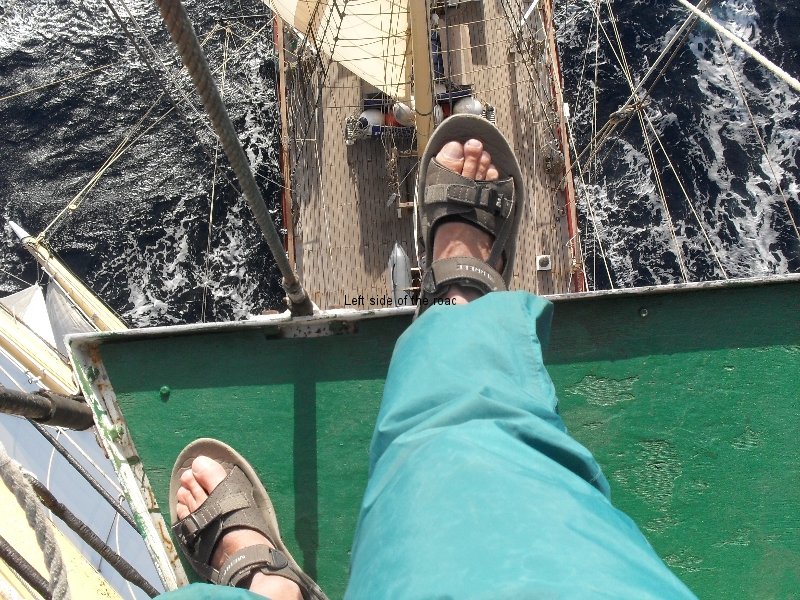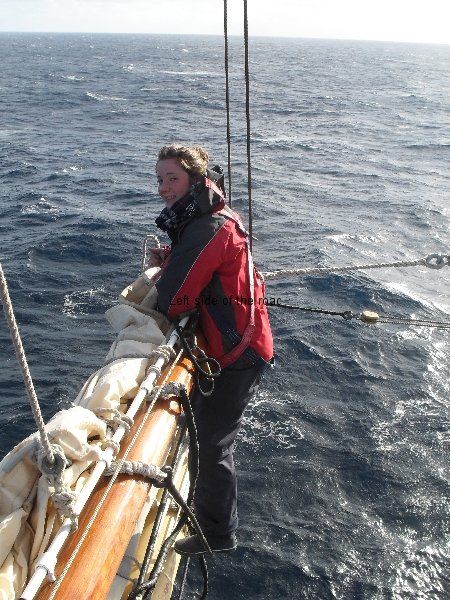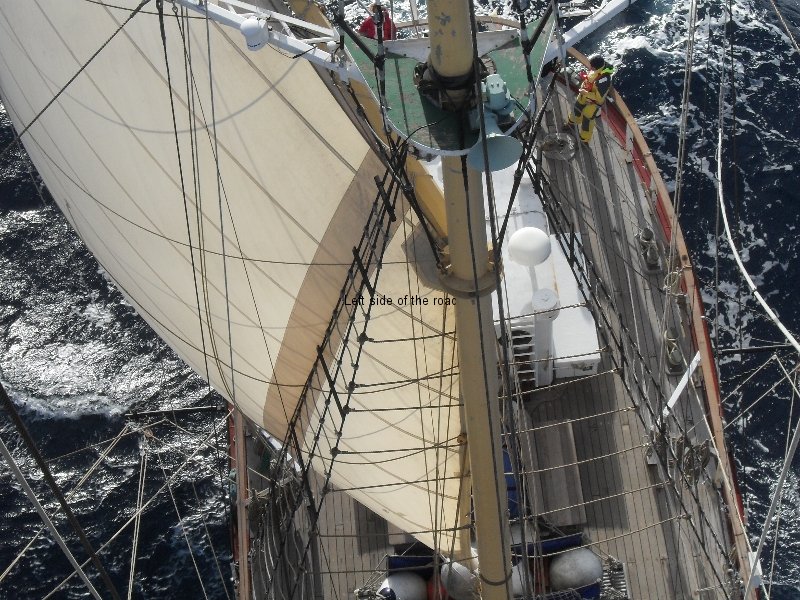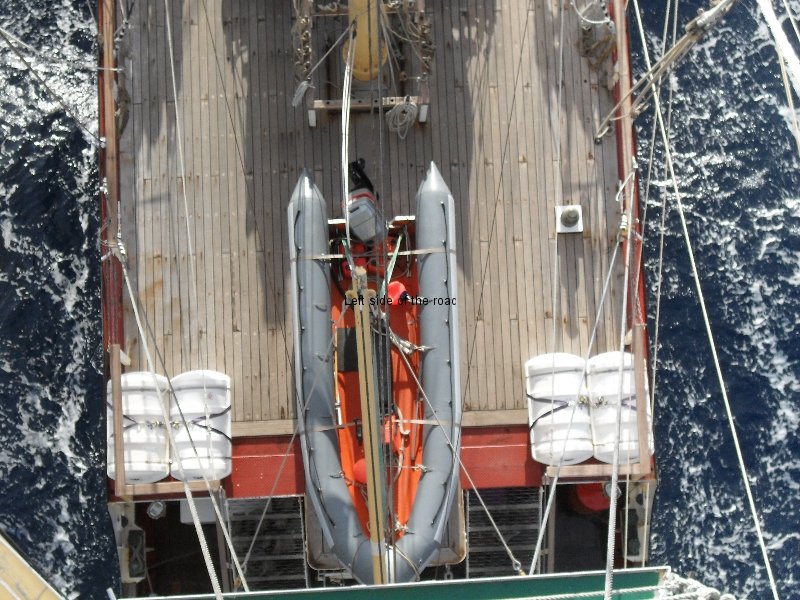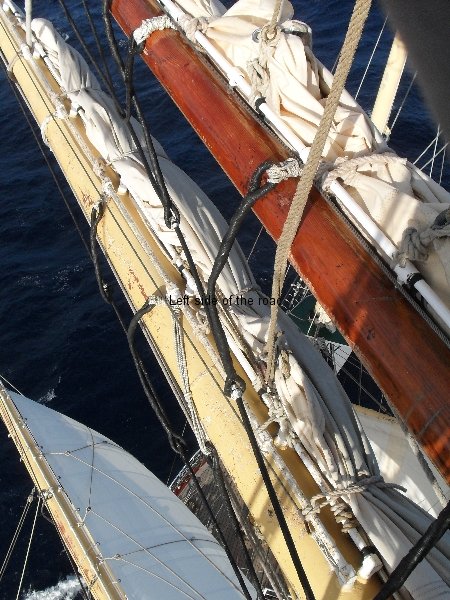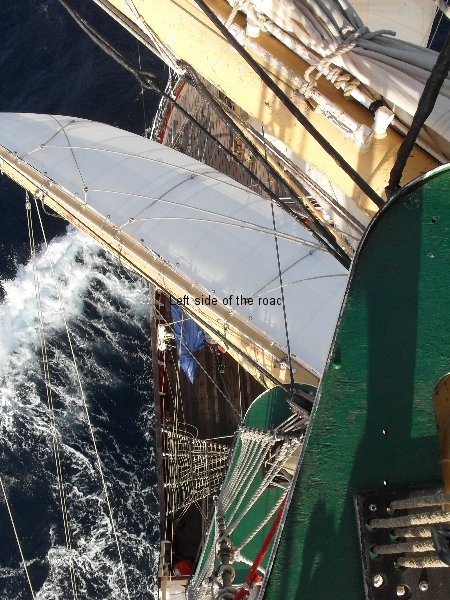
View from main mast in Mid-Atlantic
More on sailing on a tall ship
At 11.45 (more or less) on Thursday, 28th February the ship officially crossed the half way point between Bermuda and the Azores, effectively the Mid Atlantic.
How was this celebrated? Apart from many people staying in their bunks trying to catch up on sleep the answer is – not at all. There was an announcement but no real celebration. At the same time, why should there be? We had made close on 900 miles in seven days, which is considered good going, but it also meant that there was another 900 to go.
One reason that the situation was somewhat subdued could probably be accounted for by the understanding that we had at the time. This was that a second storm was ‘chasing’ us and it would catch us in the next day or so. In the morning the question was not whether but when. However, later in the day that forecast was downgraded and on the 28th there was no expectation of especially bad weather in the immediate future.
That does not mean to say, however, that there haven’t been preparations in case we have to face high winds. If they don’t come in the next couple of days there’s nothing to say later next week, or on the stretch from the Azores to the UK.
The ‘fear’ of a storm relentlessly pursuing us was made all the greater by the fact we had already gone through one (for about 30 hours) soon after leaving Bermuda. That created some impressive waves and interesting living conditions on board.
So in lieu of any celebration there was a session of tearing up cardboard and, just as that task was close to completion, a visit to the top of the main mast to try to make the two top yards more secure, the battening down the hatches approach.
Obviously I’m far from being an expert but I assume that these measures (which effectively mean that at least one of the sails couldn’t be used quickly in the future) were taken as we will be unlikely to use them in the conditions you’d expect to find in the North Atlantic in late winter/early spring.
(Here I totally misunderstood the situation. When under sail it’s best to keep the unused sails as tightly stowed as possible, to prevent any sort of damage, however minor. And it doesn’t take that long to make them ready for being set again, and this happened a number of times during the rest of the journey.)
As the trip advances volunteers are slower and fewer to go to the top of the mast when the ship is under sail. People will do so if they have to but try to reduce the time aloft. This is understandable. Apart from the precariousness of your physical position it’s hard work – especially if you are stowing away the sails. Whoever designed the rigging, either the original in centuries past or the late 20th century equivalent, the conditions for the mariners was never a high priority and the work has to be carried out in very unnatural circumstances, i.e., standing on a thick wire bent double over a yard arm.
I didn’t expect to be climbing today but (fortunately) had my compact camera in my pocket at the time so was able to capture the view you get from something like a 100 feet above the deck. They are in the slideshow below. Assuming we don’t hit particularly bad weather consistently in the next few days I hope to get up, when there is no work involved, and be able to give a better impression of what it’s like to climb the shrouds of a tall ship.
The expected length of the journey between Bermuda and the Azores was 18 days. Reaching the half way point in seven means that we can potentially cut that down to 14. And the vast majority of that has been done under sail, the engine only being used for less than a day. At the moment the seas are calm and progress is average so that full four days off the original estimate might be optimistic but there is a general attitude on board, I believe, that although it’s an achievement to cross the Atlantic in such a vessel, the quicker it can be done and we celebrate with a drink in an Azorean pub the better.
And the tearing up of cardboard? According to Marpol Regulations you are only allowed to dump cardboard in the open sea if it has been torn up into, more or less, inch square pieces. Then the location has to be recorded in a log book kept by the Bosun. It seems that this has been the situation in the Royal Navy for more than 50 years but is now part of Merchant Navy good environmental practice, but how strictly it’s kept to might be open to question.
One other point of interest, possibly, is that since leaving Bermuda behind on the afternoon of Friday 22nd February up to the night of the 28th we have only seen one ship, day or night.
It’s certainly the case that when you travel on a 114 foot sailing ship in the middle of the North Atlantic no-one can hear you scream.
And a part of me is now, forever, in mid-Atlantic. My woolly hat blew off when I was on the t’gallant yard arm and there was no great enthusiasm to stop the ship, turn around and recover it.
More on sailing on a tall ship




